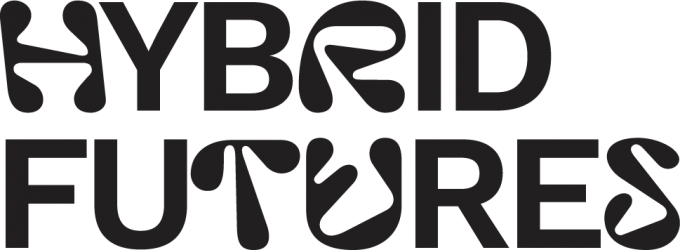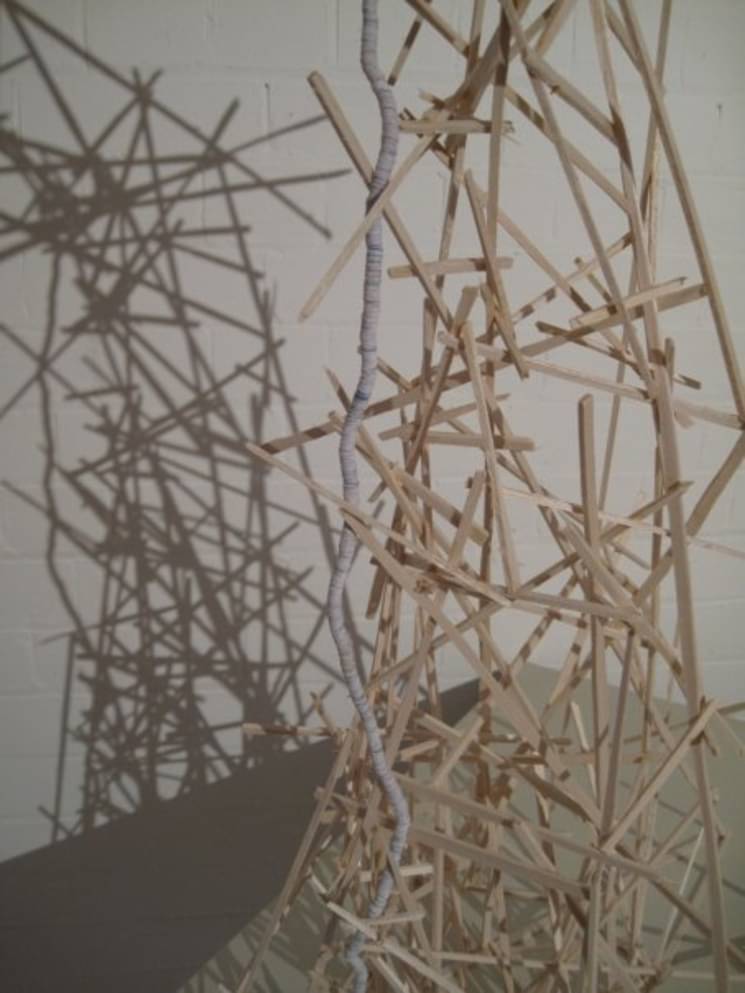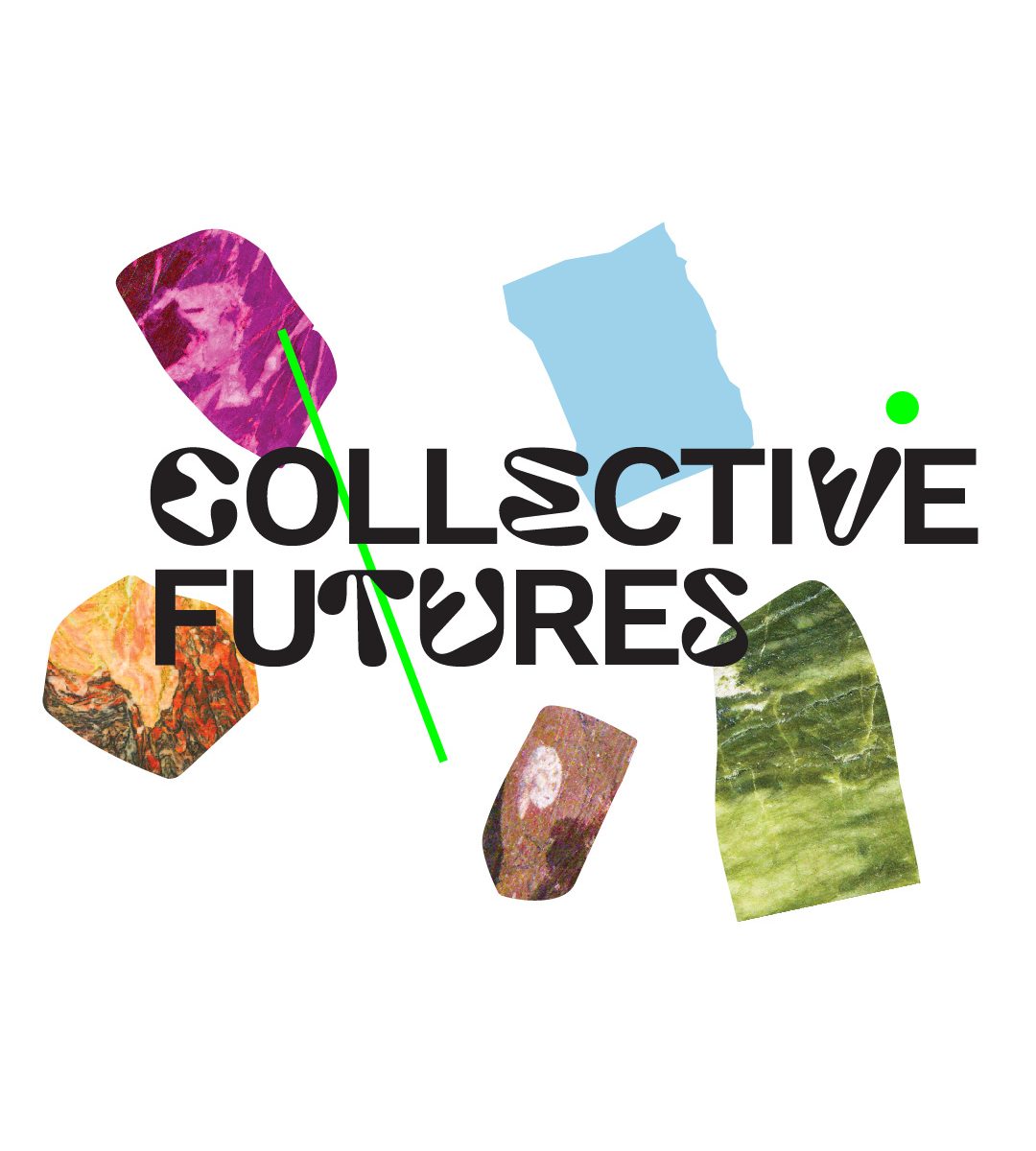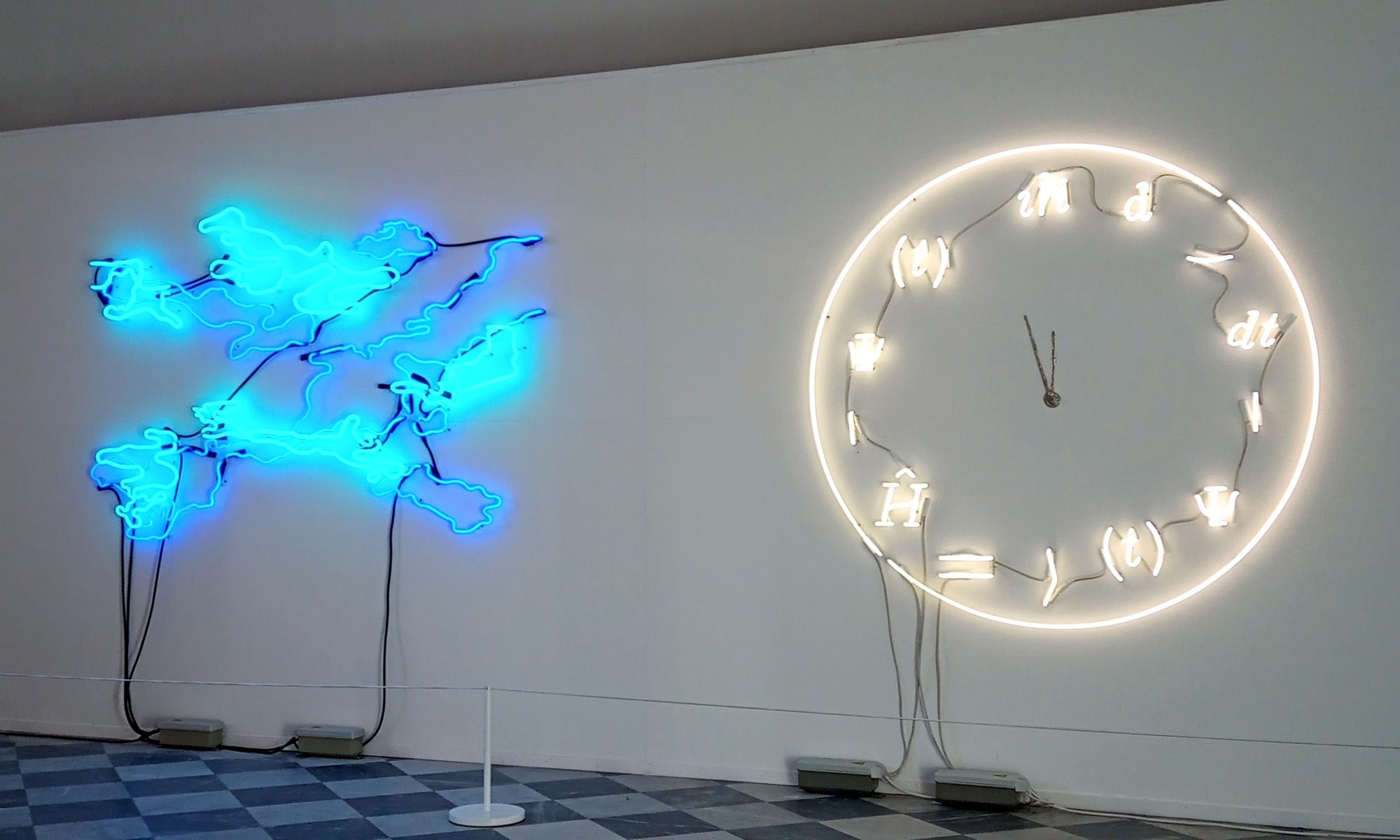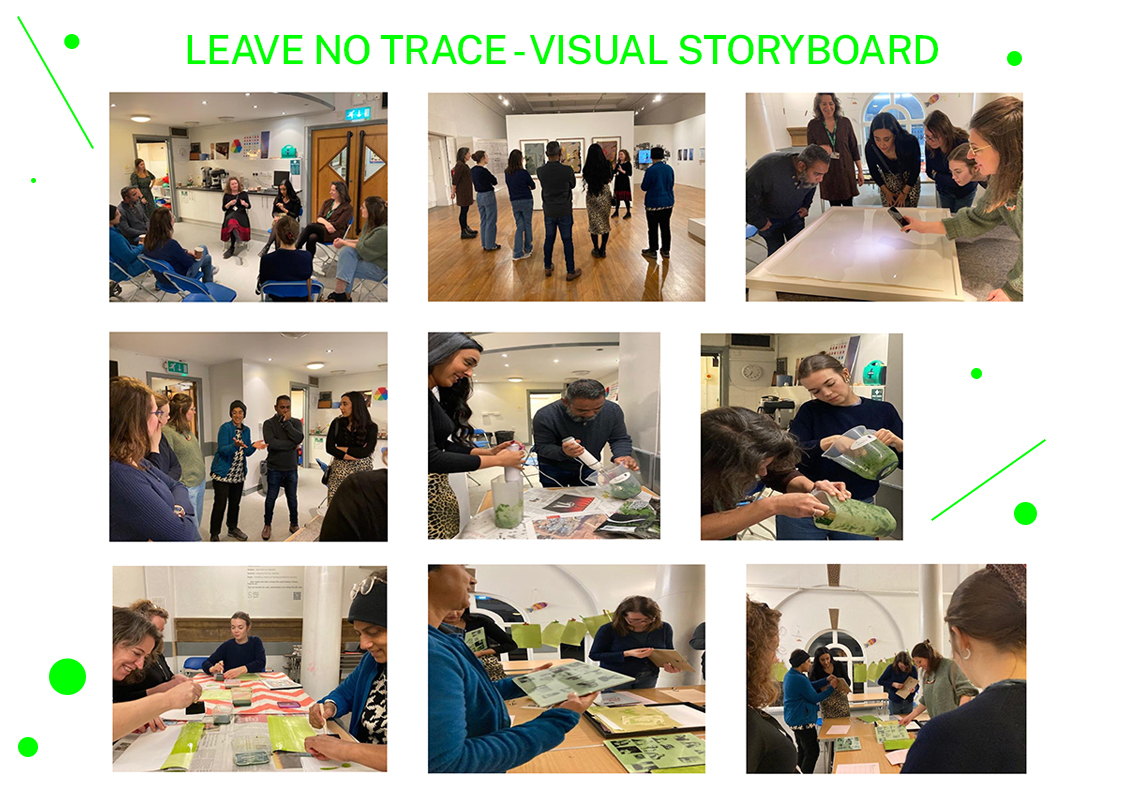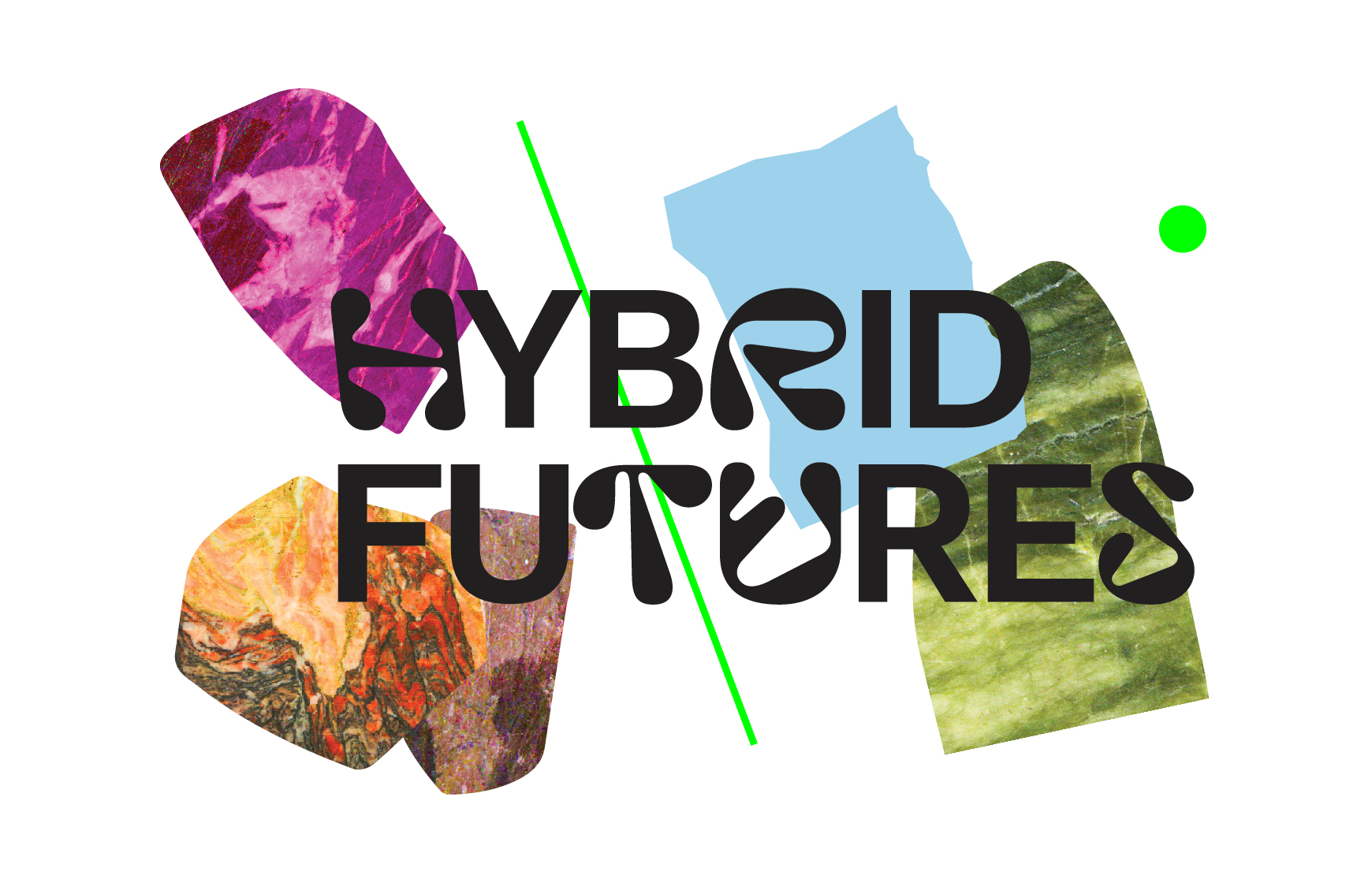This online session focused on the roles we can play to support or build projects or change. We used a metaphor of the scaffold to draw out and better understand the roles different people in Collective Futures naturally lean into – some people have ideas they want to run with, some want to support. Find out more here.
Collective Futures: Reflections Session 10 Creative Lab – online
We used the session to understand first-hand from the collective what we needed from our final session on 16 March and to learn more about one participant’s application to an Arts Climate Acceleration Programme off the back of their Christmas homework.
Our session focused on the roles we can play to support or build projects or change. We used a metaphor of the scaffold to draw out and better understand the roles different people in the Collective naturally lean into – some people have ideas they want to run with, some want to support.
One of the group reassured a newer member of the collective who was feeling like he was ‘catching up’, with how she felt entering the space in June and that the space we have created is – safe and supportive – one that cultivates personal meaning leaving the professional worries of the day aside, helping to feel uplifted by the conversations.
One of the group shared an extract from the work of Céline Condorelli, from Support Structures by Céline Condorelli, Gavin Wade, and James Langdon:
“Everything starts from this intuition: that what I define as support structures can release potential, and that support is not to be reduced to a reactive, symptomatic, and redeeming gesture, but through its uttering we may be able to hear the unspoken, the unsatisfied, the late and the latent, the in-process, the pre-thought, the not-yet manifest, the undeveloped, the unrecognised, the delayed, the unanswered, the unavailable, the not-deliverable, the discarded, the over-looked, the neglected, the hidden, the forgotten, the un-named, the unpaid, the missing, the longing, the invisible, the unseen, the behind-the-scene, the disappeared, the concealed, the unwanted, the dormant.”
Collective Futures Sessions 8 & 9
In 2023, Collective Futures focused on hearing from invited guests. We received and considered the work of artists and community activists and began to share our personal interpretation of what we are experiencing. Reflection has been a part of our sense-making; combining facts, feelings, interpretations and deciding what all of that means. Explore more here.
Collective Futures: Reflections: Sessions 8 & 9 Airing and Sharing – 12 & 20 February – online
In 2023, Collective Futures focused on hearing from invited guests. We received and considered the work of artists and community activists and began to share our personal interpretation of what we are experiencing. Reflection has been a part of our sense-making; combining facts, feelings, interpretations and deciding what all of that means.
From January 2024, the programme shifted from hearing from invited guests to hearing from each other. There were two online sessions in which the collective was invited to air and share emerging thoughts, ideas and actions they may have in response to the question: How might we best respond to the climate crisis? Responses were expected to be formative beginnings of something rather than polished, feasible scopes of work. The response to the structures ‘homework’ demonstrated how deeply some of the content had resonated with members at this formative point:
“For me, the value of Collective Futures lies in the opportunities it provides to hear from people who come from a variety of backgrounds, which are both very different and very similar to mine. It turns out we share the same struggles, but we also unlock new perspectives for each other. I think that’s the best or the only way to grow.”
“My favourite session so far was the one on Regenerative Cultures, especially the models: extractive, sustainable, resilient and regenerative. The word ‘sustainability’ has been everywhere around me – in the name of my team, my job title, our communications and strategies – literally everywhere, with the occasional reference to ‘resilience’ sprinkled in – for the last few years. Discovering the issue of sustainable vs regenerative is fascinating to me, if a little daunting, as it seems to be even more challenging to achieve than the good old sustainability. But then I remind myself that I don’t need to think about it as a corporate strategy, with lots of figures and deadlines. I can just do my best every day of my life and that’s good enough. That helps a lot. I found the idea, discussed at one of the sessions, of ‘contributing to a future world we will never experience’ to be surprisingly calming. I have faith, even though I struggle with uncertainty.”
“That session also reminded me of Debbie Yare’s words from the beginning of the project about the term ‘Ecosystem and services’ being extractive which again I found to be an interesting perspective which I’d never thought about, but which I agree with.”
“Collective Future has positively impacted my life in a very practical sense. I am fortunate to live in a residential area where most neighbours know each other, and we communicate regularly on a group chat. We discuss new ideas and initiatives, baby and cat sit for each other, and meet up for barbecues, film nights, and to celebrate birthdays or other occasions. I mentioned this project when we talked about work one day, and they sounded intrigued – a few of them are passionate about the environment. We watched the short film about POWER together and I also shared with them the story that Gemma shared at the Resonant Objects session, about the polluted river which caused lots of issues in her area (leaving out any personal details). This sparked another discussion, a wider one, about sustainability and ‘green’ initiatives, and prompted an old idea to resurface – to transform a small bit of a green space we’ve got between two of the buildings, into a community garden. Everyone offered to contribute, and it turned out we’ve already got all the resources we need in terms of tools, seeds, etc., from people’s balcony gardens (including a 2-ton bag of soil which our neighbour has somehow been storing on his balcony since last summer). We got permission from the facilities management (which I thought would be much trickier), and we’ll set the project in motion as soon as spring begins.”
“We’ve not even started yet, but even just the preparation has filled me with so much joy. It brought me back to myself in the sense that it touched and awakened my deep need to connect (with others but even more with the environment around me) and nurture, which led me to this place in my life – and ultimately Collective Futures – in the first place. Just like everything in nature, we have come full circle.”
The experience of Collective Futures to date had given the collective some new ways to think about their work and/or working practices. We sought to unlock these individual and shared responses more deeply in 2024 with sessions facilitated by Charlotte and Alia from Support Squad, sharing emergent projects and ideas we wanted to make and beginning to think about the role we might naturally lean into as a facilitator or driver of change.
Collective Futures Session 7 – Crip Ecologies and New Contemporaries
(10min Audio)
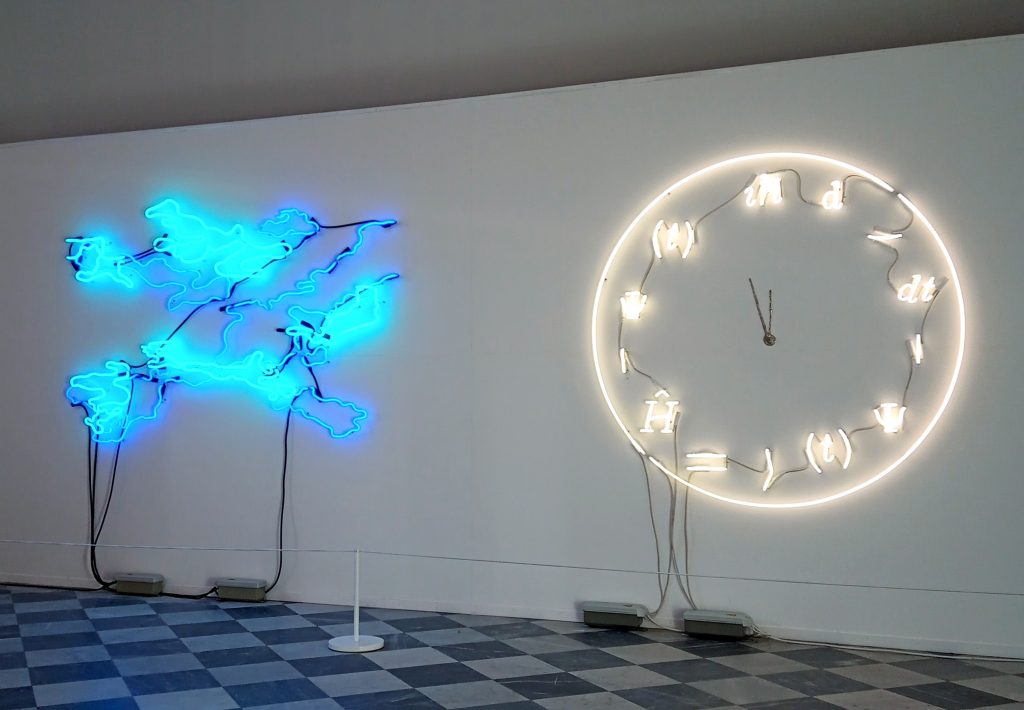
The collective met at the Grundy Art Gallery in Blackpool to view the new neon work commissioned for Hybrid Futures, RA Walden’s The Universe is a Clock (i) Schrödinger’s equation, (time dependent), 2023 and the New Contemporaries exhibition. The work of RA Walden explores Crip ecologies and non-normative readings of and relationships to time. New Contemporaries is an annual exhibition which presents the work of new graduate artists. As part of the gallery, tour the group discussed the ideas, innovations, relevance, effectiveness and voices these artists bring to the climate crisis debate.
In Blackpool library, the group took part in an exercise developed by Kit Abramson, Collective Futures’ Creative Producer and Rachel Burns, Curatorial and Community Engagement Coordinator, Touchstones with audio by RA Walden that asked the group to consider their own understandings of time. RA Walden’s work opens up questions of clock time, sick time and normative timekeeping as we occupy bodies in their varying states of health, on a planet careening toward sickness.
The collective did an exercise using metronomes – some Bakelite, some antique, large, or small, and colourful – which were laid out on a large table. The collective was each tasked to set their metronomes at the pace that they felt their body and their own embodied time was moving at that very moment. The intention was to connect as a collective, to attempt to see the ways that we are trying to share space with each other or to reach each other, when each experience time in vastly different ways. The metronomes in this exercise served as a tool to illuminate the ways that time is subjective. The collective was asked as they set their metronome to take some time to think about the ways that normative ideas of time affect their daily life. For example, how does the idea of time interact with the ideal of labour? How does our ability to imagine the future affect our ability to make change in the now, especially in relation to the climate crisis? How is time weaponised against marginalised bodies? How do our bodies fall short of the expectations of normative time? What ideas about time have I internalised that I don’t believe in? Do I feel like I have enough time? If yes, how much? If no, how little?
Once the group each found their speed and set their metronome, these were placed on the table and allowed to sit with the interrupting and interweaving beats. The group
collectively decided when everyone had had enough of listening to the cacophony of alternative times.
Discussion followed on each of our very different experience of time, reflecting back to our previous session in Salford – linking to the art collection and what we conserve, preserve, and reserve for future generations, long terms and long termism – looking for opportunity to change behaviour and make room for the ripple beyond our part in our institution or the role and influence we with have in our community.
Try the Exercise for yourself and listen to the Questions. You can download a free digital metronome too.
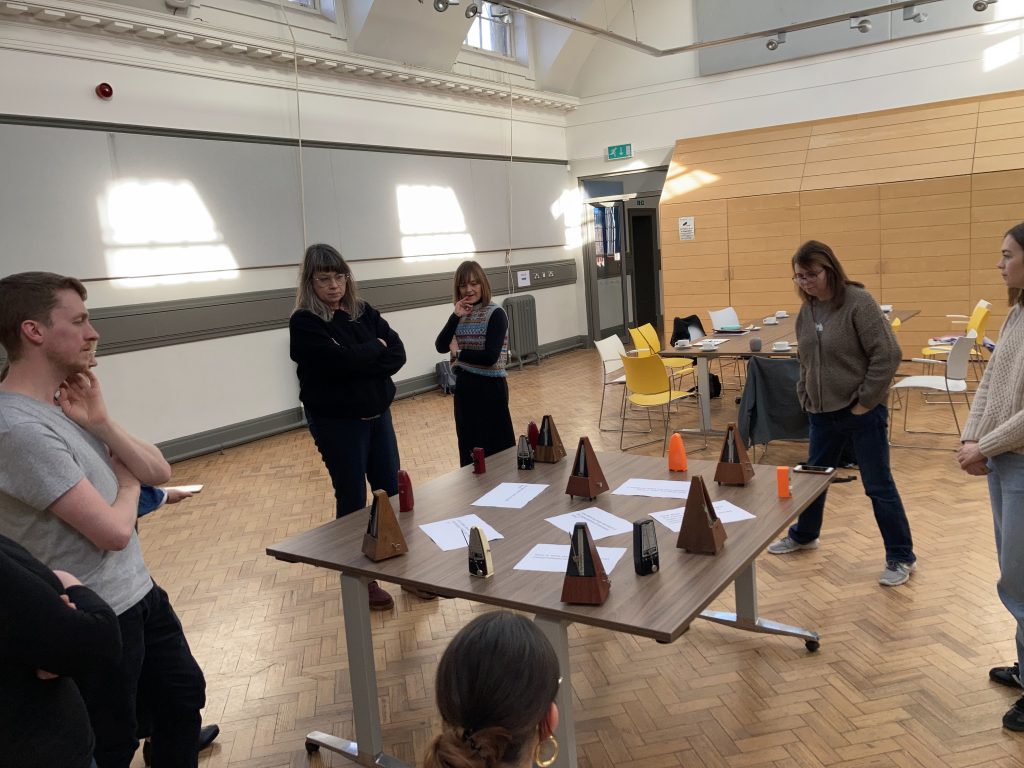
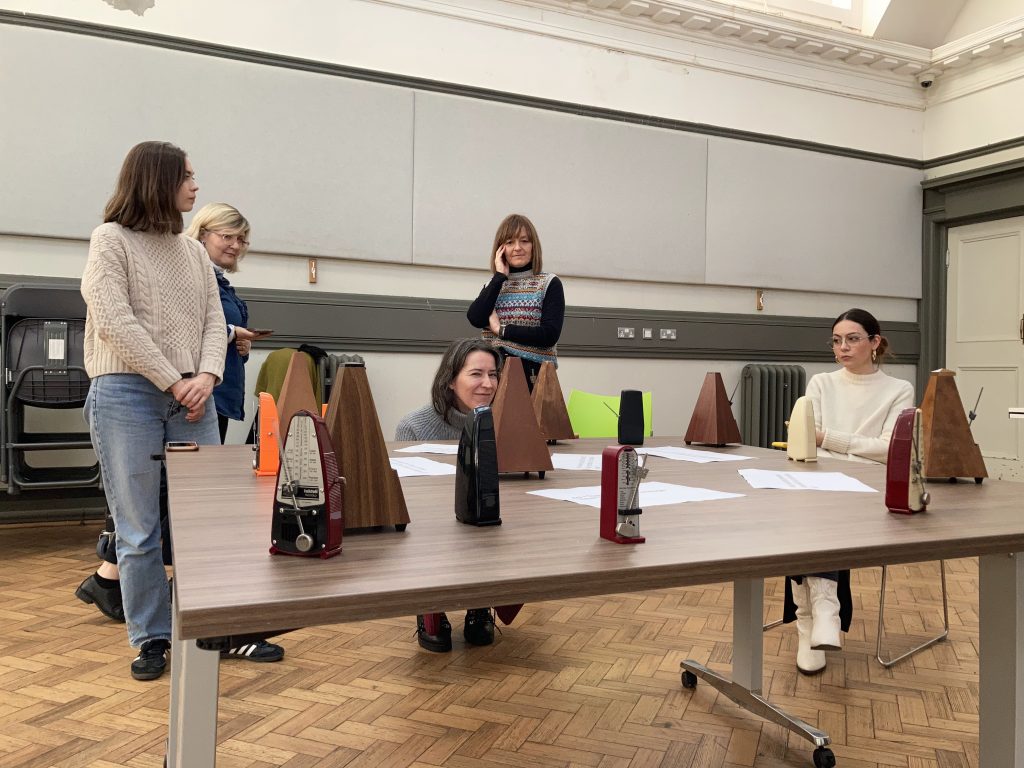
Collective Futures Session 7
Collective Futures met at the Grundy Art Gallery to view the new neon work commissioned for Hybrid Futures, RA Walden’s The Universe is a Clock (i) Schrödinger’s equation, (time dependent), 2023 and the New Contemporaries exhibition. Find out how the group considered their own understanding of time in this full report of session 7 here.
Collective Futures Session 6 – Leave No Trace
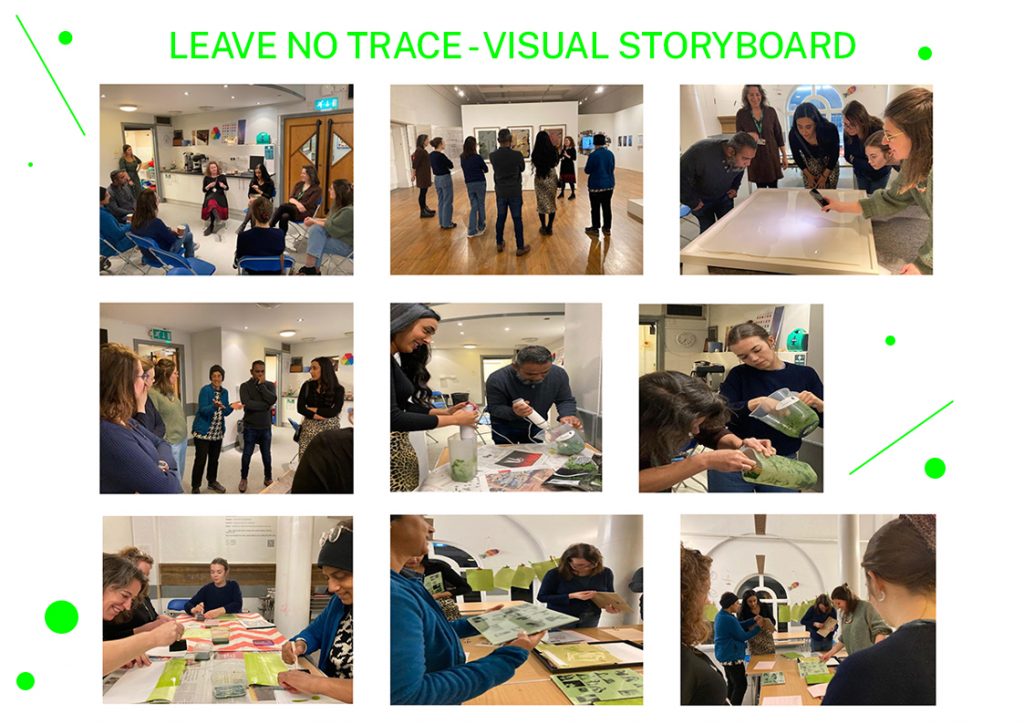
Artists are trained in mark making, printmaking, object making, film making and a multitude of ways to leave a legacy. Curators and archivists are trained in how and what to preserve of this process and cultural capital. How then can we reconcile this with ecological directives such as ‘leave no trace behind’ and ‘go zero waste’? What is sustainable making and how should we decide what is collected and valued? How can a collection or a creative practice be a vehicle for change?
To unpack these questions, photographer Gwen Riley Jones gave the collective the chance to explore sustainable photography including printing with wet spinach and take a deep dive into the University of Salford’s Art Collection to consider permanence, ephemerality and the cultural and environmental cost of creating and collecting contemporary art. The collective toured Salford Museum and Art Gallery, sharing their experiences of galleries before getting up close to interrogate three pieces of the collection and making links to place – Salford – and their sense of permanence of perspectives, bodies and materials.
Reflections were made on how the programme is iterative and how parts of earlier sessions are being internalised and embedded into the collective’s lives and workplaces beyond the reach of each session. The group left with an anthotype, to expose in sunlight, slowly at home and then note how the image fades and disappears over time. The image to expose is a montage of each member of the collective holding up their resonant objects from session three.
Collective Futures Session 6
Take a take a deep dive into the University of Salford’s Art Collection to consider permanence, ephemerality and the cultural and environmental cost of creating and collecting contemporary art with the Collective Futures cohort here.
You’re Invited: Hybrid Futures Exhibition Launch – 21st March
The latest instalment of Hybrid Futures launches at Salford Museum & Art Gallery next week. Bringing together all the work from across the Hybrid Futures project, you’re invited to join us to celebrate the exhibition launch on the 21st of March.
Exhibition Launch: Hybrid Futures
5-7 PM, Thurs 21st March 2024
Salford Museum and Art Gallery
Open to all and free to attend, refreshments provided.
RSVP here: salfordmuseum.com/event/opening-hybrid/
The exhibition brings together new work and co-commissions by Shezad Dawood, Jessica El Mal, Parham Ghalamdar and RA Walden that will mark one of the final phases of the Hybrid Futures pilot project exploring collective and more sustainable ways of working. The exhibition in Salford is presented by the University of Salford Art Collection in partnership with Salford Museum & Art Gallery. Read more about the exhibition here.
A prayer room, water and dates will be made available to anyone observing Ramadan. Want to attend earlier? We will be offering a quiet hour ahead of the exhibition launch. Please contact Rowan Pritchard if you would like to attend from 4 pm.
Planning on attending? After your visit to Hybrid Futures, don’t miss Nikta Mohammadi: Memory Stone Preview at The Lowry, also on the 21st of March from 6 until 8pm.
To travel to The Lowry from Salford Museum and Art Gallery, catch the 50 bus from the Crescent (opposite the Museum), to Media City UK. The 50 is part of The Bee Network, with easy access on all busses. For more information visit: https://tfgm.com/public-transport/bus/stops/1800NF31221/50
Ellie Harrison Environmental Policy
Ellie Harrison launched this Environmental Policy in 2010 so that visitors to her website, people interested in her work and potential collaborators are made aware of the personal commitments she makes to reduce her carbon footprint. It provides a useful model for others wanting to reduce their individual environmental impacts.

